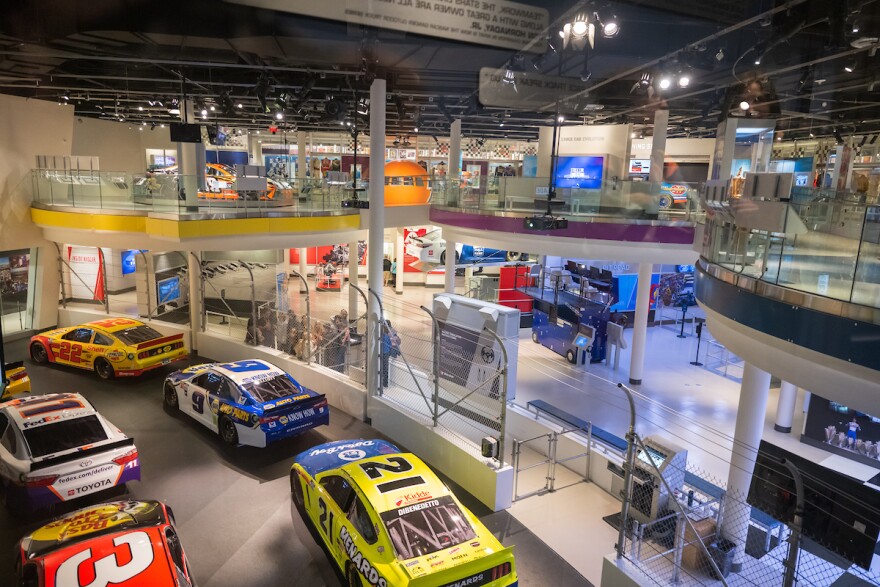You’re a driver or an engineer getting ready for the Bank of America Roval 400. How do you prepare for a road course that exists for only a few weeks each year?
At tech centers just north of Charlotte, NASCAR racing teams use sophisticated simulators that enable drivers to mark in their visual and physical memory where they need to brake, the location of every tree and every banner, and how their own car is set up for the race.

“When we go to the racetrack, we only have 20 minutes of practice,” said Chase Briscoe, who in 2018 won the first road course race ever at Charlotte Motor Speedway. He now drives the No. 14 Ford Mustang for Stewart-Haas Racing and the Ford Performance Racing School.
“So you’re really limited just from a time standpoint,” Briscoe said. “The rules that we have, you’re not really allowed to change anything when you get to the racetrack. At the simulator, we’re here for four hours, typically every week. So we can really just try all kinds of different stuff and really fine-tune our setup.”
The Bank of America Roval 400 runs on a 17-turn, 2.28-mile track reconfigured from an oval. The race starts at 2 p.m. on Sunday, Oct. 8.
No consequences from crashes
Climbing through the window of a NASCAR simulator at the Ford Motorsports Engineering facility in Concord is an entry to a world of racing with fewer risks. Worries about injury, for example, drop to zero.
“The one thing I enjoy is, when you crash in real life, that obviously hurts and here you can crash and it doesn’t hurt too bad,” Briscoe said. Simulators offer adjustments and personalization for each driver, and teams get simulator time on assigned days during the week.
Ford and the other original equipment manufacturers, GM and Toyota, provide simulation technology for the racing teams they support. Ford supports Stewart-Haas, Team Penske, Roush Fenway Keselowski, Front Row Motorsports, Rick Ware Racing and Wood Brothers Racing.
What it’s like to sit in a simulator?
Ford’s newest NASCAR simulator is located in a circular room about 25 feet in diameter. The walls serve as projection screens, and the front end of a car — called a bucket or “buck” — is attached to a platform about 3 feet off the ground. The buck rides on tracks that enable it to move within the room and simulate bumps, turns, braking, acceleration, and other functions.
Ford’s facility has three simulators, and its newest provides 360-degree visuals. The cockpit of the bucket is tight, with a seat that hugs the driver just a few inches above the floor. Shoulder straps, structural supports, switches, dials, and a removable steering wheel mimic the real thing. Engineers and crew chiefs in a control room next door study telemetry data from simulation runs and make adjustments.

Ford, GM and Toyota don’t typically discuss the cost of simulation technologies. Red Bull Racing sells a high-end consumer version of an F1 simulator for $120,000. But competitive simulators for NASCAR move in three dimensions and simulate braking, suspension and other forces. They’re also supported by a team of automotive engineers, in a facility the size of a medical office building. They undoubtedly cost well north of Red Bull’s model.
Engineers are trained in aerodynamics, programming, computer science hardware and software, engines, total vehicle systems, and other technologies, explained Matt Todd, NASCAR program engineering supervisor for Ford.
Why does Ford make the investment? Simulations in racing programs also benefit road vehicles, Todd said.
“We use the racing programs to help develop the simulator at a fast pace because we race every week,” Todd said. “That also allows us to transfer that technology to our base vehicle programs within product development.”
How different is it from the real thing?
The technology behind the image scans of NASCAR tracks is called rFpro, the commercial version of rFactor. Ford, GM and Toyota combine resources to commission the track scans, Todd said, and all three OEMs essentially get the same scan. NASCAR’s Cup Series includes 26 tracks.
Technology from rFactor supports other motorsports, along with a thriving video game business and training programs for drivers and racing teams.
Todd said simulation technology got started first in Formula 1 racing. Ford developed its first simulator in 2014, and it’s become common in NASCAR in the last 10 years. It’s also popular among fans. Last year at Charlotte’s NASCAR Hall of Fame, visitors bought 96,014 passes to climb behind the wheel of one of eight stock car simulators.

Drivers, engineers and crew chiefs all benefit, Todd said.
“For the drivers, with the limited practice time they get, it’s their opportunity to get a feel for what the car is supposed to be like. It’s an opportunity to get visualization of the track, to become familiar with the left turns, the right turns, the billboards. All the things that drivers use for visual cues are present on the simulator.”
Engineers try different setups on the car, Todd said — springs, shocks, tires, engine curves, aero maps, and other components.
“It’s incredibly important that if you’re going to be competitive and win races, when you show up at the track your car has to be really close,” Todd said. “The teams use a simulator during the week to develop those setups and hone them and develop their communication so that when they do show up at the race track and unload, their car is dialed in, and all they have to do is make small tweaks to dial it in for the weekend.”
Devonte Thomas is a student in the James L. Knight School of Communication at Queens University of Charlotte, which provides the news service in support of local community news.




